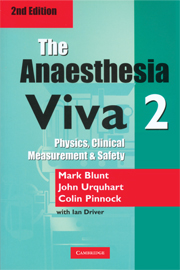Book contents
- Frontmatter
- Foreword to the First Edition
- Preface to the Second Editions
- Contents
- Physics, Clinical Measurement & Safety
- Clinical Anaesthesia
- Example 1
- Example 2
- 6 Example 3
- 7 Example 4
- Example 5
- Example 6
- Example 7
- Example 8
- Example 9
- Example 10
- Example 11
- Example 12
- Example 13
- Example 14
- Appendix 1
- Appendix 2
- Index
Example 6
Published online by Cambridge University Press: 05 February 2015
- Frontmatter
- Foreword to the First Edition
- Preface to the Second Editions
- Contents
- Physics, Clinical Measurement & Safety
- Clinical Anaesthesia
- Example 1
- Example 2
- 6 Example 3
- 7 Example 4
- Example 5
- Example 6
- Example 7
- Example 8
- Example 9
- Example 10
- Example 11
- Example 12
- Example 13
- Example 14
- Appendix 1
- Appendix 2
- Index
Summary
Scenario
You have a patient on your list for thyroidectomy. A large goitre is obvious on examination. What considerations do you make?
You should consider the possibility of an endocrine disturbance, the risk of a deformity of the airway (per- or post operatively), and the risk of existing or operatively-induced recurrent laryngeal nerve damage.
The presence of goitre is consistent with hypo-, hyper-, or euthyroid function. Biochemical thyroid function testing is therefore mandatory. Briefly, the risks of hyperthyroidism are:
▪ Cardiac arrhythmias, especially tachycardia, and atrial and ventricular fibrillation
▪ Uncontrolled hypertension
▪ Cardiac ischaemia
▪ Excessive haemorrhage
▪ Thyroid ‘storm’
The airway must be assessed clinically and with a thoracic inlet X-ray. This will reveal deviation or compression of the trachea, and allow planning of the means of airway control and anticipation of a difficult intubation; a smaller tube than usual will be needed, and elective tracheostomy has been described for massive goitre. The thoracic inlet is 10 × 5 cm and kidney-shaped, inclined 60° forwards and bounded by the first thoracic vertebra, the first ribs, and the manubrium. The integrity of the trachea may be dependent on support from the goitre, in which case tracheomalacia, with collapse of the trachea on inspiration, may occur postoperatively.
Ideally, the patient should be euthyroid and if difficult intubation is likely arrange all equipment close to hand, seek help in advance and consider fibreoptic (nasal or oral) airway instrumentation.
- Type
- Chapter
- Information
- The Anaesthesia Viva , pp. 100 - 102Publisher: Cambridge University PressPrint publication year: 2003

